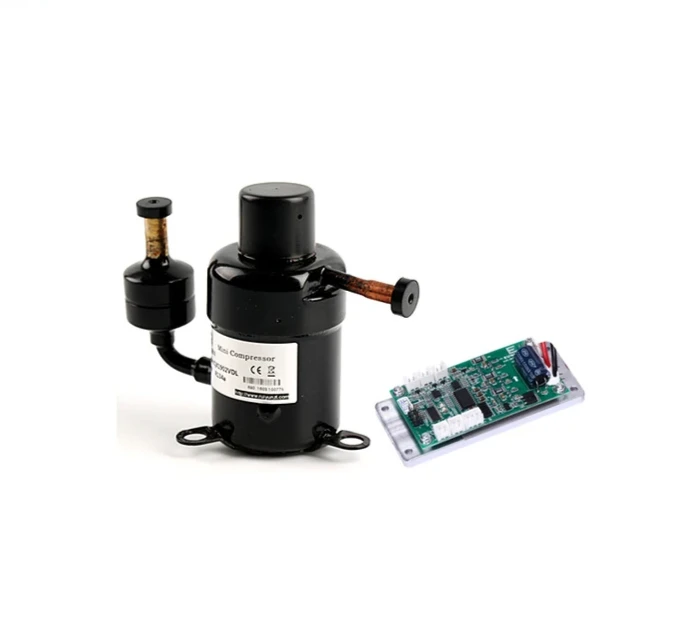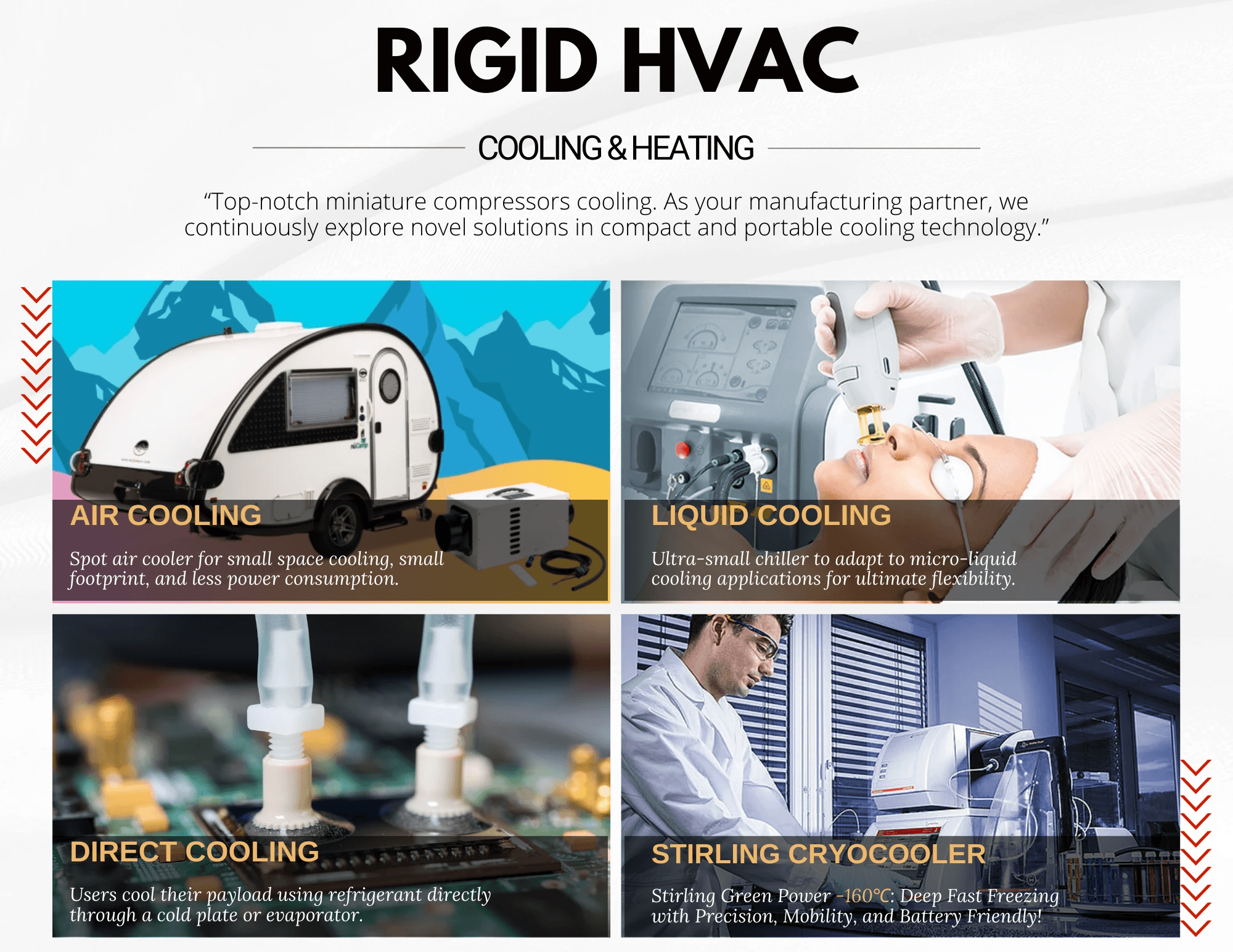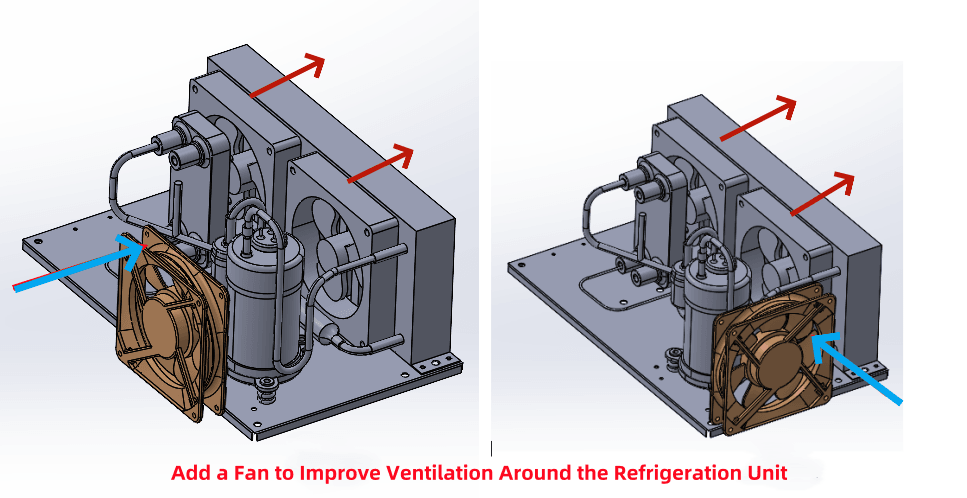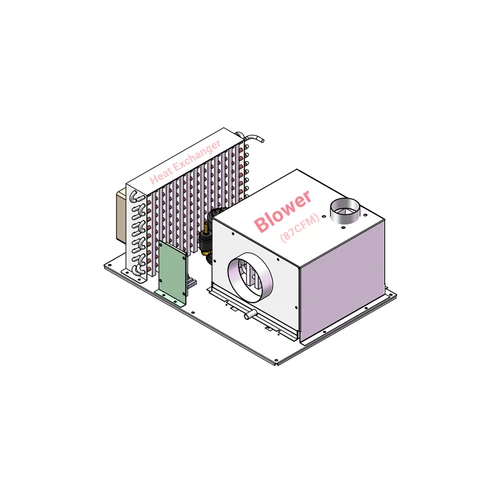Introduction

"RIGID is a miniature refrigerated compressor innovation leader in China. We keep looking for novel solutions in compact and portable cooling systems. We capture new technologies in mobile and compact cooling systems."
In the ever-evolving world of HVAC systems, understanding the role of Electronic Expansion Valves (EEVs) is crucial for both professionals and enthusiasts alike. This beginner's guide will demystify EEVs in HVAC, exploring their function, advantages, and key differences from other expansion devices like TXVs and TEVs. With the rise of Variable Refrigerant Flow (VRF) systems, knowing what EEV means in this context can significantly impact your decision-making process.
EEV in HVAC: A Beginner's Guide
So, what is EEV in HVAC? An Electronic Expansion Valve is a sophisticated device that regulates refrigerant flow based on real-time conditions within the system. Unlike traditional mechanical valves, EEVs utilize electronic sensors and controls to optimize performance, leading to enhanced energy efficiency and improved comfort levels. As we delve deeper into this topic, you'll appreciate why mastering the eev definition hvac is essential for anyone involved in modern heating and cooling solutions.
Understanding Variable Refrigerant Flow Systems
Variable Refrigerant Flow (VRF) systems represent a significant advancement in HVAC technology by allowing multiple indoor units to be connected to a single outdoor unit while varying refrigerant flow according to demand. The integration of EEV technology within VRF systems enhances their efficiency by precisely controlling refrigerant distribution based on real-time needs. By understanding how EEVs operate within these systems, you’ll be better equipped to answer questions like What is the difference between EEV and TXV? as well as What is EEV in VRF system?
Importance of Choosing the Right Expansion Device
Choosing the right expansion device can make or break an HVAC system’s performance; it’s not just about picking one at random! Selecting between options like EEVs and TXVs requires a solid grasp of their functionalities—this brings us back to our earlier discussions about eev definition hvac and its applications. Understanding these distinctions ensures optimal performance, energy savings, and longevity for your heating or cooling system; after all, who wouldn’t want that?
What is EEV in HVAC?

In the world of HVAC, understanding the intricacies of system components can be crucial for efficiency and performance. One such component is the Electronic Expansion Valve (EEV), a pivotal device that regulates refrigerant flow in cooling systems. This section will dive into the eev definition hvac, its functionality, advantages, and applications in modern HVAC systems.
Definition of Electronic Expansion Valve
An Electronic Expansion Valve (EEV) is a sophisticated device designed to control the flow of refrigerant in an HVAC system with precision. Unlike traditional expansion devices, EEVs utilize electronic sensors and actuators to adjust refrigerant flow based on real-time demand. This technology allows for improved temperature control and energy efficiency, making it a vital component for optimizing system performance.
Functionality and Advantages of EEV
The primary function of an EEV is to regulate refrigerant flow by adjusting its position according to the cooling load requirements. This dynamic adjustment leads to several advantages over conventional systems, including enhanced energy efficiency, reduced wear on components, and improved comfort levels in indoor environments. Additionally, EEVs can respond rapidly to changes in demand, ensuring that your HVAC system operates smoothly under varying conditions.
One significant advantage of using an EEV lies in its ability to maintain consistent superheat levels—a key factor for preventing compressor damage and ensuring optimal performance. Moreover, because they are electronically controlled, these valves can be integrated with advanced building management systems for even greater efficiency gains.
Applications of EEV in Modern HVAC
EEVs are increasingly being adopted across various applications within modern HVAC systems due to their versatility and effectiveness. They are commonly found in high-efficiency residential units, commercial chillers, and particularly within Variable Refrigerant Flow (VRF) systems where precise control is essential for maintaining comfort across multiple zones.
In addition to VRF applications, eev definition hvac extends into industrial refrigeration setups where precise temperature control is paramount. As buildings become smarter with IoT integration and automation technologies, the role of EEVs will only grow more critical—providing not just comfort but also significant energy savings.
What is the difference between EEV and TXV?

When navigating the world of HVAC, understanding the distinctions between various components can significantly impact system performance. One such comparison that often arises is between Electronic Expansion Valves (EEVs) and Thermostatic Expansion Valves (TXVs). Knowing what is EEV in HVAC and how it contrasts with TXV can help you make informed decisions regarding your cooling systems.
Overview of TXV and Its Functionality
A Thermostatic Expansion Valve (TXV) is a traditional device used in HVAC systems to regulate refrigerant flow based on temperature changes. Essentially, it functions by sensing the temperature of the refrigerant leaving the evaporator coil, adjusting its opening to maintain optimal superheat levels. This ensures that just the right amount of refrigerant enters the evaporator, optimizing cooling efficiency while preventing issues like flooding or starvation.
While TXVs have been reliable for years, they come with limitations that can affect overall system performance. For instance, their mechanical nature means they are slower to respond to changing load conditions compared to their electronic counterparts. In contrast, when discussing what is EEV in HVAC, we enter a realm where technology enhances control and efficiency.
Key Differences in Performance and Control
The primary distinction between EEVs and TXVs lies in their operational mechanisms. While TXVs rely on mechanical components such as diaphragms and springs for regulation, EEVs utilize electronic sensors and stepper motors for precise control over refrigerant flow. This leads to more accurate adjustments based on real-time data—allowing for improved system efficiency.
Moreover, when considering what is the difference between EEV and TXV in terms of responsiveness, EEVs shine brightly. They can adapt swiftly to variable loads or changes in ambient conditions, making them ideal for modern applications like Variable Refrigerant Flow (VRF) systems—where demand fluctuates frequently. The enhanced control offered by EEVs translates into better energy savings over time compared to traditional TXVs.
When to Choose EEV Over TXV
Choosing between an EEV and a TXV often boils down to specific application needs within your HVAC system. If your setup requires high precision under varying loads or if energy efficiency is paramount—especially in large commercial buildings—opting for an Electronic Expansion Valve makes sense. The ability of an EEV to modulate refrigerant flow dynamically ensures optimal performance across diverse operating conditions.
On the other hand, if you are working with smaller systems where initial costs are a significant concern, a TXV might still be suitable due to its lower upfront price point despite potential long-term inefficiencies. Ultimately, understanding what is the difference between TEV and EEV helps clarify which option aligns best with your project goals while considering factors like installation complexity and ongoing maintenance requirements.
What is the difference between TEV and EEV?

When it comes to HVAC systems, understanding the distinctions between various components is crucial for optimal performance. Two such components are the Thermal Expansion Valve (TEV) and the Electronic Expansion Valve (EEV). While both serve similar functions in regulating refrigerant flow, their mechanisms and efficiencies vary significantly, raising questions like What is the difference between TEV and EEV?
Definitions of TEV and Its Role
The Thermal Expansion Valve (TEV) is a mechanical device that regulates refrigerant flow based on temperature changes within an HVAC system. It operates using a thermostatic element that responds to the temperature of refrigerant vapor leaving the evaporator, adjusting flow accordingly to maintain desired cooling levels. In contrast, when we discuss What is EEV in HVAC?, we refer to a more advanced electronic device that uses electronic sensors for precise control over refrigerant flow.
TEVs have been widely used in traditional HVAC setups for decades, providing reliable performance with minimal complexity. However, as technology advances, many systems are shifting towards EEVs due to their enhanced efficiency and adaptability. Thus, while TEVs have their place in HVAC history, they may not always be the best choice for modern applications.
Performance Comparisons Between TEV and EEV
When comparing performance between TEVs and EEVs, one must consider factors such as accuracy, efficiency, and system responsiveness. The EEV boasts superior accuracy because it adjusts refrigerant flow continuously based on real-time data from multiple sensors throughout the system. In contrast, TEVs operate more reactively; they adjust based on temperature fluctuations but lack continuous monitoring capabilities.
Moreover, What is the difference between EEV and TXV? can also be explored here since both valves exhibit varying levels of efficiency under different conditions. While TEVs may perform adequately under stable conditions, their limitations become apparent during fluctuating loads or variable environmental factors—where EEVs shine by optimizing performance dynamically.
In terms of energy savings as well as operational reliability across diverse conditions—EEVs generally outperform TEVs by a significant margin. This leads us to consider when each valve type might be most appropriate depending on specific system requirements.
Ideal Scenarios for TEV Usage
Despite advancements in technology favoring EEVs in many scenarios—there are still situations where employing a Thermal Expansion Valve makes sense. For instance, simpler or smaller HVAC systems often benefit from using a TEV due to its straightforward design requiring less maintenance compared to electronic counterparts like an EEV or even when asking What is EEV in VRF system?
Additionally, cost considerations play a role; installing multiple TEVs can sometimes be more economical than investing heavily into an entire system designed around sophisticated electronic controls found with an Electronic Expansion Valve setup. Therefore—when evaluating your options—it’s essential not only to ask about performance differences but also about budget constraints alongside long-term operational goals.
In conclusion—the decision between utilizing a TEV or an EEV hinges upon understanding your specific needs within your HVAC framework while considering future scalability options!
What is EEV in VRF system?

In the world of HVAC, understanding the role of Electronic Expansion Valves (EEV) in Variable Refrigerant Flow (VRF) systems is crucial for maximizing efficiency and performance. The EEV definition in HVAC revolves around its ability to precisely control refrigerant flow based on real-time demand, making it an essential component for modern heating and cooling solutions. With the increasing complexity of climate control needs in commercial and residential buildings, recognizing what EEV is in VRF systems can lead to significant energy savings and enhanced comfort.
Importance of EEV in Variable Refrigerant Flow
The importance of EEV in Variable Refrigerant Flow cannot be overstated; these devices ensure that the right amount of refrigerant circulates through the system at any given time. By adjusting the flow dynamically, EEVs respond to varying load conditions, which is particularly beneficial for buildings with fluctuating occupancy or usage patterns. This adaptability not only improves overall system performance but also contributes to lower operational costs—an essential consideration when evaluating what is EEV in HVAC applications.
Moreover, integrating an EEV into a VRF system allows for more precise temperature control across different zones within a building. This level of control leads to enhanced occupant comfort while simultaneously reducing energy waste—a win-win situation! When considering what is the difference between EEV and TXV, it's clear that while both serve similar purposes as expansion devices, the electronic nature of EEVs provides them with superior responsiveness and efficiency in variable environments.
How EEV Enhances VRF Efficiency
EEVs significantly enhance VRF efficiency by utilizing advanced sensors and algorithms to optimize refrigerant flow based on real-time conditions. Unlike traditional expansion devices such as TXVs or TEVs—which operate based on preset mechanical settings—EEVs continuously monitor system parameters like pressure and temperature, allowing them to make instantaneous adjustments. This dynamic regulation means that systems equipped with EEVs can maintain optimal performance even during drastic changes in load conditions.
Additionally, because these valves can adjust more finely than their mechanical counterparts, they help reduce energy consumption by minimizing compressor cycling—one of the biggest culprits behind inefficiency in HVAC systems. When pondering over what is the difference between TEV and EEV, it becomes evident that TEVs often struggle with rapid fluctuations due to their mechanical nature while EEVs thrive under such circumstances due to their electronic controls. Thus, choosing an EEV for a VRF system not only enhances operational efficiency but also ensures longevity by reducing wear on critical components.
Case Studies of EEV in VRF Systems
Several case studies showcase how integrating Electronic Expansion Valves into Variable Refrigerant Flow systems has led to remarkable improvements across various applications. For instance, a large commercial office building equipped with a state-of-the-art VRF system featuring multiple indoor units reported a 30% reduction in energy costs after switching from traditional TXVs to advanced EEvs—demonstrating clear benefits from understanding what is EEV in HVAC contexts.
Another notable example includes a hospitality establishment that implemented an innovative VRF solution using EEvs; they experienced improved guest comfort levels alongside significant reductions in maintenance expenses due to fewer mechanical failures compared to previous setups using TEVs. These success stories reinforce why selecting an appropriate expansion device matters—and highlight how knowing what is the difference between TEV and EEV can inform better decision-making processes.
In summary, embracing Electronic Expansion Valves within Variable Refrigerant Flow systems marks a pivotal step toward achieving enhanced efficiency and reliability across diverse HVAC applications—a truly smart investment for any modern building management strategy!
RIGID Innovations in Mini Compressors

RIGID is at the forefront of revolutionizing mini compressor technology, offering compact solutions that are both efficient and powerful. These mini compressors are designed to maximize performance while minimizing space, making them ideal for modern HVAC applications. With a focus on innovation, RIGID has integrated advanced features that enhance reliability and energy efficiency in cooling systems.
Overview of RIGID's Mini Compressor Technology
RIGID's mini compressor technology is engineered to deliver high performance in a surprisingly small footprint. This design not only caters to the growing demand for space-saving solutions but also aligns with the need for enhanced energy efficiency in HVAC systems. The incorporation of electronic expansion valves (EEV) within these compressors allows for precise control, optimizing refrigerant flow based on real-time demands—making it a game-changer in the industry.
The question What is EEV in HVAC? often arises when discussing modern cooling solutions, especially with RIGID's innovative approach. By utilizing EEVs, these mini compressors can adapt quickly to changing conditions, ensuring optimal performance and comfort levels. Furthermore, this adaptability contributes significantly to the overall efficiency of variable refrigerant flow (VRF) systems.
Advantages of RIGID's Compact Cooling Solutions
One of the standout advantages of RIGID's compact cooling solutions is their ability to offer high efficiency without compromising on power output. This means that even smaller units can deliver exceptional cooling capabilities while using less energy—a win-win for both consumers and the environment. Additionally, these innovations help reduce installation costs and time due to their lightweight design and straightforward integration into existing systems.
When comparing different technologies like EEVs versus traditional devices such as TXVs or TEVs, it's clear why many professionals are leaning towards RIGID’s offerings. The flexibility provided by electronic expansion valves enhances system responsiveness and performance consistency across various operating conditions—an essential feature when exploring What is the difference between EEV and TXV? or What is the difference between TEV and EEV?
Client Testimonials and Case Studies
RIGID has garnered positive feedback from numerous clients who have experienced significant improvements in their HVAC systems after switching to mini compressors equipped with EEV technology. Many users report lower energy bills due to enhanced efficiency while enjoying consistent temperature control throughout their spaces—a key factor when considering What is EEV in VRF system?
Case studies illustrate how businesses have achieved remarkable results by implementing RIGID’s solutions; one notable example includes a commercial building that reduced its energy consumption by 30% after retrofitting its HVAC system with RIGID’s mini compressors featuring advanced electronic expansion valves (EEV). Clients rave about not just cost savings but also improved overall comfort levels within their environments.
Conclusion
In the ever-evolving world of HVAC, understanding the role of Electronic Expansion Valves (EEVs) is crucial for optimizing system performance. As highlighted throughout this guide, EEVs revolutionize how we manage refrigerant flow, offering precise control and enhanced efficiency in various applications. Whether you're considering what is EEV in HVAC or exploring its integration into Variable Refrigerant Flow (VRF) systems, the significance of this technology cannot be overstated.
Recap of EEV Importance in HVAC
To revisit the essence of EEV definition HVAC, it’s clear that these valves are integral to modern cooling systems. They provide unparalleled flexibility and responsiveness compared to traditional devices like Thermal Expansion Valves (TXVs). By maintaining optimal refrigerant flow under varying conditions, EEVs not only improve energy efficiency but also enhance overall system reliability.
Making Informed Choices Between EEV and TXV
When pondering what is the difference between EEV and TXV, it becomes evident that each has its place within HVAC design. While TXVs are reliable for many conventional setups, EEVs shine in scenarios demanding precise control and adaptability—especially in systems like VRF where load conditions fluctuate significantly. Ultimately, making informed choices between these two options hinges on understanding your specific application needs and desired outcomes.
Embracing RIGID for Future Cooling Solutions
As we look towards the future of cooling solutions, embracing innovative technologies like RIGID's mini compressors will be essential. Their advancements complement the benefits found in electronic expansion valves by offering compact yet powerful solutions for diverse applications. With a commitment to excellence and customer satisfaction, RIGID stands poised to lead the charge in redefining efficiency standards across the HVAC industry.